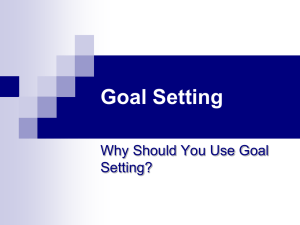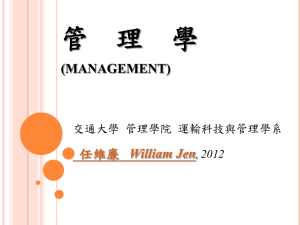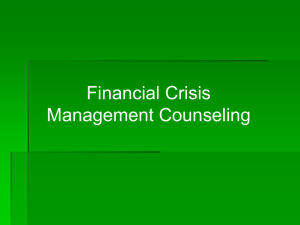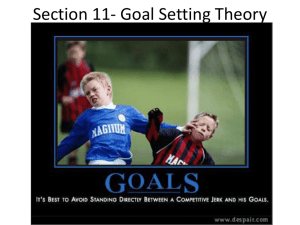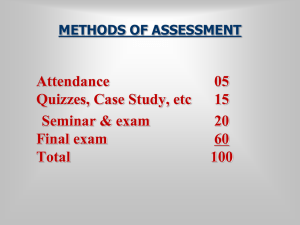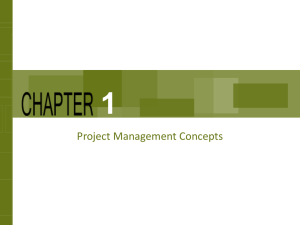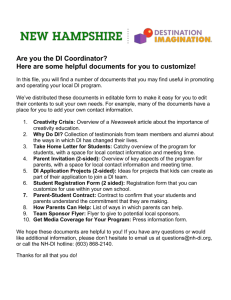Strategic Plan
advertisement
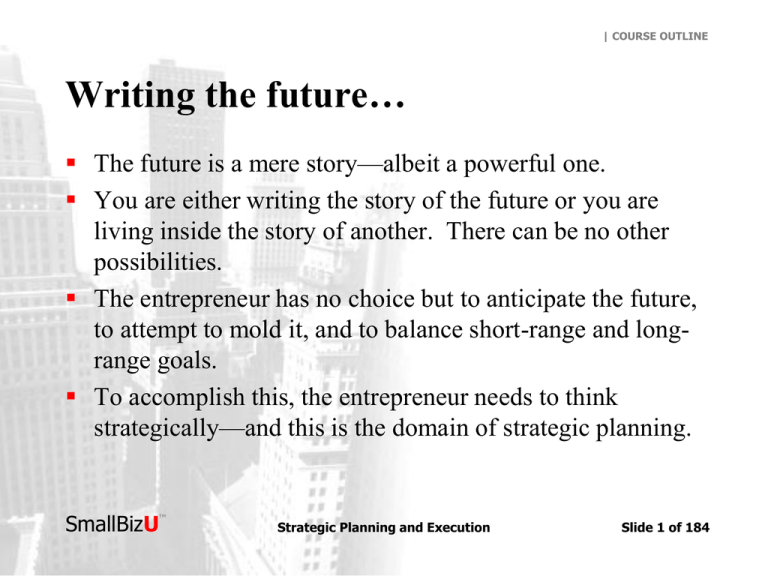
| COURSE OUTLINE Writing the future… The future is a mere story—albeit a powerful one. You are either writing the story of the future or you are living inside the story of another. There can be no other possibilities. The entrepreneur has no choice but to anticipate the future, to attempt to mold it, and to balance short-range and longrange goals. To accomplish this, the entrepreneur needs to think strategically—and this is the domain of strategic planning. SmallBizU ™ Strategic Planning and Execution Slide 1 of 184 | COURSE OUTLINE Strategic planning is… A tool for organizing the present on the basis of projections of the desired future. Determines where an organization is going over the next few years, how it is going to get there and how it will know if it got there. A road map to lead an organization to where it would like to be in five to ten years. Measuring the results of these decisions against the expectations through organized systematic feedback. SmallBizU ™ Strategic Planning and Execution Slide 2 of 184 | COURSE OUTLINE It doesn’t deal with future decisions… Strategic planning deals with future-aspects of present decisions. Decisions exist only in the present. The question that faces the strategic decisionmaker is not what his/her organization should do tomorrow. It is, “What do we have to do today to be ready for tomorrow?” SmallBizU ™ Strategic Planning and Execution Slide 3 of 184 | COURSE OUTLINE It doesn’t attempt to eliminate risk… It is not even an attempt to minimize risk. Economic activity, by definition, commits present resources to the future. While it is futile to try to eliminate risk, it is essential that the risks taken be the right risks. The end result of successful strategic planning must be the capacity to take greater risks, for this is the only way to improve performance. SmallBizU ™ Strategic Planning and Execution Slide 4 of 184 | COURSE OUTLINE The devices of strategic planning… Each device in strategic planning is meant to answer one fundamental question about your plan: – Vision: Answers the question of “what.” What will our future look like? What will we accomplish? What is our dream with a deadline? – Mission: Answers the question of “why.” Why do we exist? Why is our vision important? – Goals: Answer the questions of “who and when.” Who will do what? When will they do it? – Strategy: Answers the question of “how.” How will we achieve our goals? How will our vision bring our mission to life? SmallBizU ™ Strategic Planning and Execution Slide 5 of 184 | COURSE OUTLINE Knowing Your Vision And Mission SmallBizU ™ Strategic Planning and Execution Slide 6 of 184 | COURSE OUTLINE Mission and Vision… Though the terms are often used interchangeably, there is a vast difference between a mission and a vision. While the two concepts play-off of one another, they work in very different ways. It is important to examine exactly what makes mission and vision different and to demonstrate why you need to have both. SmallBizU ™ Strategic Planning and Execution Slide 7 of 184 | COURSE OUTLINE Clarity about mission and vision… Clarity about mission and vision is both an operational and spiritual necessity. Vision provides a guiding star, a long-term purpose that allows you to balance the inevitable pressures between the short-term and the long-term. Mission translates vision into truly meaningful intended results—and guides the allocation of time, energy, and resources. It is only through a compelling vision that a deep sense of purpose comes alive. SmallBizU ™ Strategic Planning and Execution Slide 8 of 184 | COURSE OUTLINE The dynamic interplay… Vision is about preserving the core… – – – – Provides continuity and stability Fixed stake in the ground or the horizon Limits possibilities Conservative act Mission is about stimulating progress… – – – – Urges continual change Impels constant movement Expands possibilities Revolutionary change SmallBizU ™ Strategic Planning and Execution Slide 9 of 184 | COURSE OUTLINE The eyesight metaphor… Mission and Vision are like your eyes. Each is independent of one another, yet each works together to provide both depth and breath ultimately coming together to make one in sight. The absence of one or the other (or both) is akin to looking at your organization with one only eye…or less. It can truly be said that nothing happens until there is a vision. But it is equally true that a vision with no underlying sense of purpose is just a good idea—all sound and fury, signifying nothing. SmallBizU ™ Strategic Planning and Execution Slide 10 of 184 | COURSE OUTLINE What is Vision? Vision is the purpose or reason for existence of your organization. It is a general heading or direction—it is abstract. A vision is what you stand for. A vision should be timeless. It should rarely, if ever, change. It should stand the test of time. Example: “To increase man’s capability to explore the heavens.” SmallBizU ™ Strategic Planning and Execution Slide 11 of 184 | COURSE OUTLINE The ground-rules of vision… Paradoxically, if an organization’s vision is truly motivating it is never really achieved. Vision provides an orientation, not a checklist of accomplishments. It defines a direction, not a destination. It tells the members of an organization why they are working together and how they intend to contribute to the world. Without a sense of vision, there is no foundation for establishing why some intended results are more important than others. SmallBizU ™ Strategic Planning and Execution Slide 12 of 184 | COURSE OUTLINE Power from ideas not people… Vision is therefore the belief that power ultimately flows from ideas, not people. Moreover, vision is inherently fuzzy and abstract. It is so much easier to make decisions based on the numbers, habit, and unexamined emotions. To be vision-minded requires everyone to think continuously. SmallBizU ™ Strategic Planning and Execution Slide 13 of 184 | COURSE OUTLINE Now it’s time to write your vision… Right now on a piece of paper, write down your vision statement. . SmallBizU ™ Strategic Planning and Execution Slide 14 of 184 | COURSE OUTLINE The vision in review… Remember a vision statement should be somewhat timeless—it should apply to not only today but possibly fifty years from now. It should put forth a general direction or heading stating what it is that you stand for. In essence, a vision can never really be achieved—it should be ongoing. If it can be achieved and completed then it is a mission or goal, not your vision. You should think of your vision as your guiding star. SmallBizU ™ Strategic Planning and Execution Slide 15 of 184 | COURSE OUTLINE Finally, check your vision… Your vision should… – Provide continuity and stability – Act as a fixed stake in the ground or the horizon – Limit possibilities A good strategic plan is rooted in the vision statement SmallBizU ™ Strategic Planning and Execution Slide 16 of 184 | COURSE OUTLINE Defining A Mission SmallBizU ™ Strategic Planning and Execution Slide 17 of 184 | COURSE OUTLINE What is mission? A mission is a specific future destination—it is concrete. A mission is a dream with a deadline. It should change over time. It must say “yes” to some ideas and “no” to others. It’s about what the future might be, could be, and shouldn’t be. Example: “To put a man on the moon before the end of the 1960’s.” SmallBizU ™ Strategic Planning and Execution Slide 18 of 184 | COURSE OUTLINE Defining a mission… In some ways, defining mission is easier than knowing your purpose or vision. Mission—an image of the future we seek to create—is synonymous with intended results. SmallBizU ™ Strategic Planning and Execution Slide 19 of 184 | COURSE OUTLINE The ground-rules of Mission… Mission is a practical tool, not an abstract concept. Missions can be long-term or intermediate term. While an organization should exist for one, single purpose, multiple missions can coexist, capturing complimentary facets of what people seek to create and encompassing different time frames. SmallBizU ™ Strategic Planning and Execution Slide 20 of 184 | COURSE OUTLINE Mission-based leadership… Leaders who lack vision fail to define what they hope to accomplish in terms that can ultimately be assessed. While vision is foundational, it is also insufficient because, by its nature, it is extraordinarily difficult to assess how we are doing by looking only at the vision. For this we need to stick our necks out and articulate “an image of the future we seek to create.” Leaders, therefore, must have both a mission and a vision. Results mean little without purpose. SmallBizU ™ Strategic Planning and Execution Slide 21 of 184 | COURSE OUTLINE Now lets define your mission… Remember, a mission is a specific, future destination. It’s your dream with a deadline. Therefore, the first thing we need to do is establish a time frame that we want to look ahead. You will obviously choose the time frame(s) that best fits your specific mission, but for the sake of this exercise, we are going to look out 5 years into the future. SmallBizU ™ Strategic Planning and Execution Slide 22 of 184 | COURSE OUTLINE Ask yourself such questions as… What big, audacious goal(s) do you want to try to achieve in five years from now? What does success look like in five years? In five years time, how should your organization be different than it is now? Using your own measurement of success, what must you accomplish in five years for you to consider yourself successful? SmallBizU ™ Strategic Planning and Execution Slide 23 of 184 | COURSE OUTLINE Now review what you have written… Remember a mission should be a description of a specific future destination. It should speak to what your future should be and to what it shouldn’t be. It should excite the human imagination over a long period of time. It should be bold, but there must be a belief that it can be achieved. Remember: It’s not what the mission is, it’s what the mission does. SmallBizU ™ Strategic Planning and Execution Slide 24 of 184 | COURSE OUTLINE Finally, check your mission… Your mission should… – – – – Urge continual change Impel constant movement Expand possibilities Result in revolutionary change SmallBizU ™ Strategic Planning and Execution Slide 25 of 184 | COURSE OUTLINE Having a mission is but one facet… Having a well-defined mission is not enough by itself to transform an organization to greatness—an organization must also have a good handle on its current reality. And so, defining the current reality of the situation in all of its gory detail is equally important. It sets the stage for the future story that is about to unfold. Truly creative organizations use the gap between mission and reality to generate energy for change. SmallBizU ™ Strategic Planning and Execution Slide 26 of 184 | COURSE OUTLINE Forming Goals And Objectives SmallBizU ™ Strategic Planning and Execution Slide 27 of 184 | COURSE OUTLINE What are goals and objectives? Goals are your definition of what success looks like. Goals are your mission in miniature. They specify what work of your mission will get done, by who, and by when. In effect, goals pose the question, “What will I have to accomplish by the end of this year to consider myself a success?” SmallBizU ™ Strategic Planning and Execution Slide 28 of 184 | COURSE OUTLINE The purpose of goals and objectives… Objectives clarify what it is you are trying to accomplish in specific, measurable goals. For an objective to be effective, it needs to be a welldefined target with quantifiable elements that are measurable. Whereas your mission statement is expansive and idealistic, and the vision short, powerful, and memorable, your objectives are designed to focus your resources on achieving specific results. The purpose of well-defined objectives is to cause meaningful action. SmallBizU ™ Strategic Planning and Execution Slide 29 of 184 | COURSE OUTLINE Developing your goals… Think back to your mission statement once again. If you recall, your mission statement looked five years into the future toward a specific destination that you want to arrive at. Next, read your current reality description that you wrote. Now think about the activities you need to accomplish this year in order to move from your current situation toward that destination. Create 5 to 6 objectives for each goal that are critical to arriving at your envisioned future. SmallBizU ™ Strategic Planning and Execution Slide 30 of 184 | COURSE OUTLINE What do you need to accomplish? To create a solid objective you must: 1. Describe the activity required. Example: Introduce new products or services… 2. Describe what will happen and when: To teach life skills such as cookery, sewing and knitting, provide counseling services in a bid to promote self reliance, positive attitudes and the ability to cope with life /societal problems. 3. You can then wordsmith these pieces into a complete objective: – By the end of the year 2009, an establishment of a comprehensive high quality secondary school for disadvantaged girls, aged 12 – 20 years, in Omoro Sub county, Gulu District, will be completed SmallBizU ™ Strategic Planning and Execution Slide 31 of 184 | COURSE OUTLINE Creating S.M.A.R.T. Objectives Specific Measurable Attainable Realistic Timely SmallBizU ™ Strategic Planning and Execution Slide 32 of 184 | COURSE OUTLINE Specific - A specific objective has a much greater chance of being accomplished than a general objective. To set a specific objective you must answer the six "W" questions: *Who: Who is involved? *What: What do I want to accomplish? *Where: Identify a location. *When: Establish a time frame. *Which: Identify requirements and constraints. *Why: Specific reasons, purpose or benefits of accomplishing the goal. EXAMPLE: A general objective would be, "Get in shape." But a specific objective would say, "Join a health club and workout 3 days a week." SmallBizU ™ Strategic Planning and Execution Slide 33 of 184 | COURSE OUTLINE Measurable - Establish concrete criteria for measuring progress toward the attainment of each goal you set. When you measure your progress, you stay on track, reach your target dates, and experience the exhilaration of achievement that spurs you on to continued effort required to reach your goal. To determine if your objective is measurable, ask questions such as......How much? How many? How will I know when it is accomplished? Attainable - When you identify goals that are most important to you, you begin to figure out ways you can make them come true. You develop the attitudes, abilities, skills, and financial capacity to reach them. You begin seeing previously overlooked opportunities to bring yourself closer to the achievement of your goals. You can attain most any goal you set when you plan your steps wisely and establish a time frame that allows you to carry out those steps. SmallBizU ™ Strategic Planning and Execution Slide 34 of 184 | COURSE OUTLINE Realistic - To be realistic, a objective must represent a goal toward which you are both willing and able to work. A goal can be both high and realistic; you are the only one who can decide just how high your goal should be. A high goal is frequently easier to reach than a low one because a low goal exerts low motivational force. Your objective is probably realistic if you truly believe that it can be accomplished. Timely - A objective should be grounded within a time frame. With no time frame tied to it there's no sense of urgency. If you want to lose 10 lbs, when do you want to lose it by? "Someday" won't work. But if you anchor it within a timeframe, "by May 1st", then you've set your unconscious mind into motion to begin working on the goal. SmallBizU ™ Strategic Planning and Execution Slide 35 of 184 | COURSE OUTLINE Example of well-defined objectives… Vision: By 2005, 50% of all revenue will occur through our own branded product line. One year objectives: – Secure trademark and other intellectual property by February 28th. – Establish website with e-Commerce capabilities by March 15th. – Complete 8 products by the end December 31st. – Secure 10 content licenses by October 1st. SmallBizU ™ Strategic Planning and Execution Slide 36 of 184 | COURSE OUTLINE Presenting Strategy As Story SmallBizU ™ Strategic Planning and Execution Slide 37 of 184 | COURSE OUTLINE Presenting a strategy… The methods, craft, and techniques by which you present a strategy are different from those used to create it. Contrary to conventional wisdom, PowerPoint presentations, statistics, and rational argument-style methods are not the most effective ways to communicate your strategic plan. Leaders know the best way to engage listeners on a whole new level is to toss the rational, statistical presentations and learn to tell good stories instead. SmallBizU ™ Strategic Planning and Execution Slide 38 of 184 | COURSE OUTLINE Persuasion using rhetoric… A big part of an entrepreneur’s job is to motivate people to reach certain goals. To do that, he or she must engage their emotions, and the key to their hearts is story. There are two ways to persuade people. The first is by using conventional rhetoric, which is what most business people are trained in. It’s an intellectual process, and in the business world it usually consists of a PowerPoint slide presentation in which you say, “Here is our company’s biggest challenge, and here is what we need to do to prosper.” And you build your case by giving statistics and facts and quotes from authorities. SmallBizU ™ Strategic Planning and Execution Slide 39 of 184 | COURSE OUTLINE A way to persuade… A way to persuade people—and ultimately a much more powerful way—is by uniting an idea with an emotion. The best way to do that is by telling a compelling story. In a story, you not only weave a lot of information into the telling but you also arouse your listener’s emotions and energy. SmallBizU ™ Strategic Planning and Execution Slide 40 of 184 | COURSE OUTLINE Harnessing the imagination… Persuading with a story is hard. Any intelligent person can sit down and make lists. It takes rationality but little creativity to design an argument using conventional rhetoric. But it demands vivid insight and storytelling skill to present an idea that packs enough emotional power to be memorable. If you can harness imagination and the principles of a welltold story, then you get people rising to their feet amid thunderous applause instead of yawning and ignoring you. SmallBizU ™ Strategic Planning and Execution Slide 41 of 184 | COURSE OUTLINE Humans want stories… Stories have been implanted in you thousands of times since your mother took you on her knee. You’ve read good books, seen movies, attended plays. What’s more, human beings naturally want to work through stories. Psychologists describe how the human mind, in its attempt to understand and remember, assembles the bits and pieces of experience into a story, beginning with a personal desire, a life objective, and then portraying the struggle against the forces that block that desire. Stories are how we remember; we tend to forget lists and bullet points. SmallBizU ™ Strategic Planning and Execution Slide 42 of 184 | COURSE OUTLINE Telling strategic stories… People not only have to understand their organizations’ past, but then they must project the future. And how do you imagine the future? As a story. You create scenarios in your head of possible future events to try to anticipate the life of your organization or your own personal life. So, if a person understands that his or her own mind naturally wants to frame experience in a story, the key to moving an audience is not to resist this impulse but to embrace it by telling a good story. SmallBizU ™ Strategic Planning and Execution Slide 43 of 184 | COURSE OUTLINE What makes a good story? You emphatically do not want to tell a beginning-to-end tale describing how results meet expectations. This is boring and banal. Instead, you want to display the struggle between expectation and reality in all its nastiness. For example: – Let’s imagine the story of a biotech start-up we’ll call Chemcorp, whose CEO has to persuade some Wall Street bankers to invest in the company. He could tell them that Chemcorp has discovered a chemical compound that prevents heart attacks and offer up a lot of slides showing them the size of the market, the business plan, the organizational chart, and so on. The bankers would nod politely and stifle yawns while thinking of all the other companies better positioned in Chemcorp’s market. SmallBizU ™ Strategic Planning and Execution Slide 44 of 184 | COURSE OUTLINE The alternative pitch… Alternatively, the CEO could turn his pitch into a story, beginning with someone close to him—say, his father— who died of a heart attack. So nature itself is the first antagonist that the CEO-asprotagonist must overcome. The story might unfold like this: – In his grief, he realizes that if there had been some chemical indication of heart disease, his father’s death could have been prevented. His company discovers a protein that’s present in the blood just before heart attacks and develops an easy-to-administer, low-cost test. SmallBizU ™ Strategic Planning and Execution Slide 45 of 184 | COURSE OUTLINE The craft of story… Designing story tests the maturity and insight of the writer, his knowledge of society, nature, and the human heart. Story demands both vivid imagination and powerful analytic thought. There is no magic formula for you to use in crafting a story to present your strategic plan—there is only craft. SmallBizU ™ Strategic Planning and Execution Slide 46 of 184
